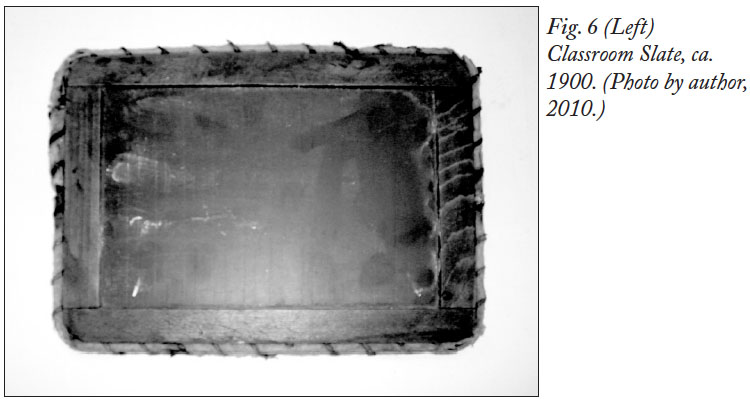Research Reports/ Rapports de recherche
Material Culture and Schooling:
Possible New Explorations in the History of Canadian Education
1 This paper offers favourable answers to the question of whether the examination of material culture of schooling can broaden our historical understanding of school reform and development in Canada and whether it can offer new insights into the way we approach the study of educational history. An analysis of the material culture of schooling is essentially absent in Canadian educational historiography. With historians of education overwhelmingly focused on education policy and policy-making, the shift from fountain pens to ballpoint pens, for example, at first glance does not seem to offer any meaningful information about the history of education in Canada. A critical analysis of that material evidence, however, will show that that shift was anything but irrelevant to what has taken place inside schools. The material culture of schooling has played an important part in the experience of growing up. What children have learned, how they have thought, what they have thought about and how they came to make decisions about the future course of their lives while in school, were all affected by the physical things that surrounded them, and so we ought to begin to pay closer attention to these things.
2 To be sure, there has been a growing body of international research concerned with the materiality of schooling stemming from an emerging interest among scholars about questions of space and place in the making of the modern world. Martin Lawn and Ian Grosvenor suggest the importance of school buildings, teaching aids, school furniture and other objects in shaping the educational environment in their collection, Materialities of Schooling: Design, Technology, Objects, Routines (Lawn and Grosvenor 2005).Objects, the authors put forward, form sites of schooling in which people, things and routines are closely connected. Those objects should not remain invisible if we are to seriously study schools as sites of learning. In Designing Modern Childhoods,Marta Gutman and Ning de Conick-Smith suggest the importance of material culture in the construction of childhood memories and experiences (Gutman and Coninck-Smith 2008). As parents and adults crafted and manipulated the material world of childhood, children appropriated and made sense of that world in ways that would impact their identities and shape their lives as adults. A recent volume of the British journal History of Education devoted solely to questions of space, place and materiality in the history of education puts forward a similar case (Burke, Cunningham and Grosvenor 2010). In it, scholars from Europe, the United States and Australia challenge the traditional writing of the history of education and force us to rethink the sources used to understand and interpret the educational past. The articles in that special issue, however, focus predominantly on architecture and architects, and the ways in which educational authorities created and used school space, while a consideration of the material culture of objects and artifacts is left wanting. Frederik Herman, Angelo Van Gorp, Frank Simon and Mark Depaepe take up that task in a critical analysis of school desks in Belgium in the first half of the 20th century (Herman et al. 2011). Their focus, however, concentrates on the intentions behind the production phase of the school desk and again falls back on documentary evidence such as public contracts, photographs, advertising leaflets and patents in order to answer questions about certain school desks that were effectively produced for use in the schools of Brussels.
3 In Canada, considerations of space and place are diverse, but limited insofar as their focus on material culture is concerned. Certain scholars have considered school and classroom architecture in their analysis of schooling in 19th-century Ontario and the ways in which school reformers created carefully controlled schools. Their research, however, is based primarily on documentary evidence, mainly government records, and thus does not get us beyond the archival walls (Houston and Prentice 1988). Kai Mah has explored the visual culture of Ontario’s educational environment in the 19th century through a critical analysis of the Ontario Educational Exhibition at the Centennial International Exposition in Philadelphia in 1876 (Mah 2007). Mah finds that educational landscapes in Ontario facilitated industrial modernity’s production of difference in space, identities, gender and labour, while promoting the educational progress of the British Empire. Mah’s research, however, is also focused on the intentions of the educational elite in charge of creating Ontario’s educational environment. Christine Lei takes us further into the physical world of education as she considers the material culture of schooling in a micro-study of the Loretto School for Girls in Hamilton, Ontario (Lei 2000). Lei analyzes both the interior and exterior structures of the school and its adjacent residence through an analysis of the archaeological and architectural documented sources of the buildings. The school’s cultural values, she suggests, both influenced and were influenced by this material reality. Lei finds that the material culture of the school shaped the personal mobility, as well as the personal identities, of those inside.
4 Building on the analytical frameworks of these scholars, this paper considers some of the material culture of schooling in Canada since the 19th century, and suggests that through an analysis of school artifacts we can learn more about the history of education in Canada and the development of mass schooling since its colonial origins. It does this through an analysis of the Ottawa Catholic School Board Collection housed at the Canadian Museum of Civilization. In 2009, the “Education Museum” of the Ottawa Catholic School Board outgrew its facility’s space, and so the decision was made to donate the entire collection to the Canadian Museum of Civilization. The collection consists of more than 700 artifacts that date from the early 19th century to the early 21st century. The foundation of the Ottawa Catholic School Board’s Education Museum was the private collection of Mae Rooney, a former school teacher and principal in the Ottawa Catholic schools. In 2000, the Historical Committee of the school board entered into talks with Rooney to purchase her collection, which consisted of unique memorabilia including textbooks, provincial examinations, school bells, a set of pupil lunch kits dating from the early 1800s and a complete series of Catechisms used in Ontario Catholic schools (OCCSB 2007: 45). The museum was opened in 2000, and its collection continued to grow until 2009, when the Education Museum entered into talks with the Canadian Museum of Civilization for the transfer.
5 The range of artifacts is large, and they were grouped under the following categories: school supplies; teacher and student clothing; furniture; teaching aids and equipment; photographs; outdoor school signs and flags; first aid, dental and other medical equipment; instructional classroom signs; decorative items; personal student items (including lunchboxes and thermal containers); educational toys; religious objects; student-produced matter (including art work, writing, yearbooks and textbooks); and other miscellaneous items. In addition, more than one thousand schoolbooks were donated, dating from the 1850s to the 1990s. The books span the curriculum and include everything from early childhood reading to lessons for adolescents on moral behaviour and regulation.
6 More than 80 per cent of the objects in the collection originate from the Ottawa area; the other 20 per cent originate from other parts of Canada. The researcher should thus be careful to note that the collection’s name, “Ottawa Catholic School Board Collection,” refers to its original owners and not to the origins of all artifacts themselves. That is, while the bulk of the collection is representative of the history of schooling under the Ottawa Catholic School Board, the collection does not represent only the Ottawa Catholic School Board’s history. The collection therefore offers the researcher the opportunity to consider the material culture of schooling in a broader context than the Ottawa region. However, even using the collection to look at the history of the school board proves to be problematic in other ways. The board itself is a recent creation of Bill 104, which saw the Carleton Roman Catholic Separate School Board and the Ottawa Roman Catholic Separate School Board merge in 1997. These two boards have quite different histories: one was predominately rural, the other, urban. The Ottawa Roman Catholic Separate School can trace its origins to 1856, and its primary mission was to offer a separate Catholic education for the City of Ottawa. The Carleton Roman Catholic Separate School Board, on the other hand, has a much younger history. It was created in 1969 from a consolidation of separate schools in the rural area surrounding the City of Ottawa after county-wide school boards were imposed by the province (OCCSB 2007: 27). From its inception, the rural school board experienced growth, reflecting the suburban boom years of post-war Canada. Prior to that, however, rural separate schools continually struggled with finances. Formal separate schools in Ontario tended to be created only where the numbers would warrant. Unlike demographic conditions in the City of Ottawa, rural Catholics in the area often struggled with maintaining the numbers for a separate school. As a result, the rural schools were often under-financed and had to make due with whatever material and resources they could afford (OCCSB 2007: 15-17).
7 The collection as a whole offers us material insight not into the history of a single school board but into the history of a region that witnessed the transformation of public schooling in a variety of geographic, economic and cultural contexts. We thus find in the collection objects from colonial one-room rural schoolhouses as well as objects from 20th-century, multi-room, multi-floor urban school buildings. It is incumbent upon the researcher to qualify his or her analysis of the objects in light of the geographic, economic and cultural realities they may represent. In other words, while the present paper attempts to consider the trends and themes in educational history that can be drawn from this history, it would be a mistake to make too many broad generalizations about the history of education through an analysis of the collection as a whole. The collection does not have a monolithic origin; rather, it is a collection of material from different schools with different needs.
8 What follows, then, is a consideration of a sample of objects connected to familiar themes in Canadian educational history. The sample is not intended to be exhaustive, but rather to suggest the type and quality of material evidence the researcher has available in order to shed new light on, and broaden our historical understanding of, the experience of schooling. It asks us to move beyond the questions of why and when schools and school policies were created, and toward the question of what school was like and whether we can meaningfully connect with schooling’s past through its material remains. I have identified five categories that will help us understand Canadian educational history in the 19th and 20th centuries: space and place; discipline and moral regulation; teaching aids and pedagogy; school health and hygiene; and symbolic representations of identity in the classroom. While the Catholic artifacts, signs and symbols in the collection that shaped the ethos of the schools will be discussed, specifically Catholic material culture of schooling has not been isolated as a category of exploration. Instead, my intention is to consider the themes and trends in educational history that would have been common to public, Catholic and private systems of education throughout Canada.
Space, Place and Order
9 Were schools in 19th-century Canada orderly places? Certain scholars suggest that they were surely intended to be, with authorities consciously linking schooling to the governing of children (Prentice 1977; Houston and Prentice 1988; Curtis 1988, 1992). The role of school desks indeed supports such claims. School desks are not simply pieces of furniture. They are, in a word, the locus of learning in the classroom. They are also the locus of order and control. In the doubleseated desks of the mid- to late 19th century, we can see this emphasis on order. Physically, if we are to take these desks as our cue, schools were a constraining place (Fig. 1). The typical desk seated two pupils per seat. The shared seat was itself attached to the desktop of the two pupils seated behind. The shared desktop was attached to the seat of the two pupils seated in front. Thus, at any given time, four students shared a single piece of furniture, and the furniture one worked on was shared with at least five others. The desks made it easy to distribute space in the classroom and provided optimum room for the teacher to move around the classroom and monitor student work. They also maintained order by making it difficult for students to move around, lest they disturb the work of others.
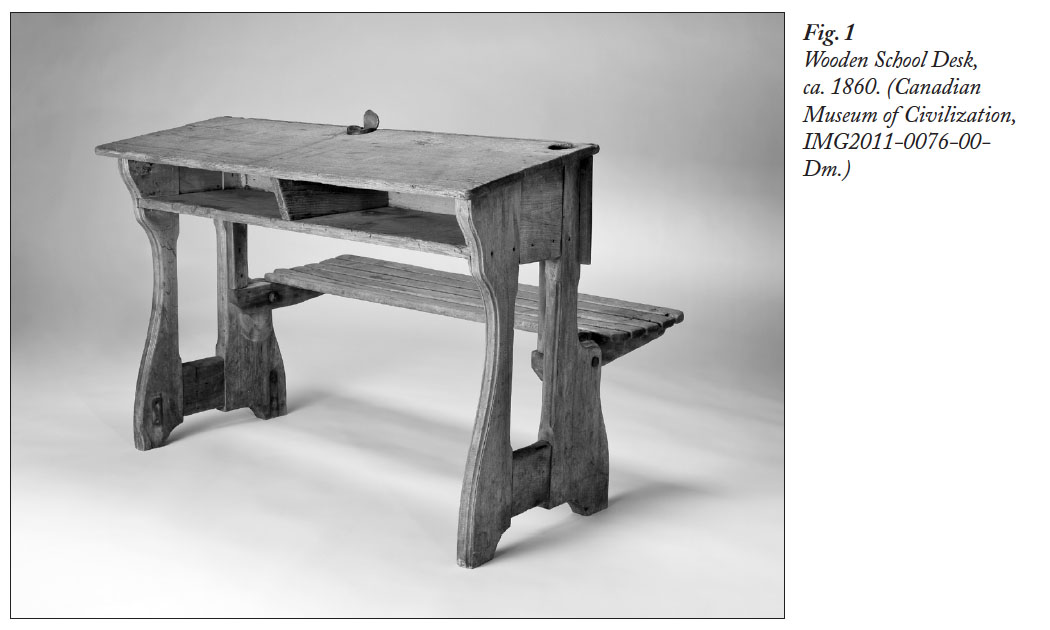 Display large image of Figure 1
Display large image of Figure 110 By the end of the 19th century, however, central authorities began to rethink the school desk and the workspace in general. A photograph of the Model Kindergarten at the Toronto Normal School in 1898 insinuates that space, much space in fact, was valued and promoted by school reformers (Fig. 2). In the Model Kindergarten of the late 19th century, future teachers would look on as children comfortably worked on various tasks in a well–laid out and spacious learning environment.
 Display large image of Figure 2
Display large image of Figure 211 Despite the plans and classroom designs of central authorities, as depicted in the Model Kindergarten of 1898, the surviving materials in the Ottawa Catholic School Board Collection imply that children continued to experience only a limited amount of space, especially desk space, until the 1960s. Prior to that decade, the confining double-seated desk with attached desktop continued to prevail. In their study of Belgian school desks, Herman et al. suggest that school reformers began to take the issue of school furniture seriously somewhere between 1900 and 1950. In that period, sixty-eight patents for school furniture were granted in Belgium alone. Although the study does not say why many of the applications were rejected, the criteria for successful school furniture patents, according to Herman’s reading of patent applications in that period, seem to have been based on school hygiene, safety, order, control and ease of use (Herman et al. 2011).
12 What can the popularity and longevity of the classic double-seated desk tell us about the history of education in Canada? Did certain perceptions of order continue to dominate inside of the schools despite the ideas being promoted by central authorities? Did local school administrators ignore the new ideas about classroom space promoted by educational thinkers in the early 20th century? Or, were decisions simply made along economical lines? That is, was it simply cheaper to furnish a classroom with the doubleseated desks, or not to replace the furniture at all? Of course, the answers are not clear cut and vary according to social, demographic and geographic factors. The economic concerns of rural schools, for example, were quite different from those of urban schools. Given the financial struggle that rural Ottawa schools faced prior to the 1969 amalgamation of the various schools into a single school board (OCCSB 2007: 27), it is unlikely that they could have afforded to overhaul their school furniture in order to keep up with changing ideas about classroom space that were being promoted in universities and by provincial school administrators. It should therefore come as little surprise to learn, through this collection, that schools in Ottawa and its surrounding areas were frugal in their spending on new furniture. Whatever the reasoning, the surviving desks we find in the material history record provide us with a connection to the physical experience of school children while seated at their desks. These desks may very well have meant that children experienced this space as a lack of freedom of mobility. Whatever the content of the lessons taught in the classroom, and whatever the intentions of curriculum designers, school desks had a message of their own.
Discipline and Moral Regulation
13 Along with the double-seated desk, other objects also transmitted values of order and control, as well as discipline and moral regulation. Some of the signs we find in the 19th- and 20th-century classrooms virtually speak for themselves in this regard. A classroom sign (Fig. 3) speaks volumes about moral regulation and teachers’ attempts to create self-regulating and self-governing children. Little is known about the origins of the sign, or how widespread its use might have been, other than a handwritten note, presumably from the school board museum’s curator, affixed to the back of it identifying it as being from the Ottawa valley and from ca. 1930. The impact of such a sign on what a child thought about while in the classroom can really only be appreciated when we consider that it might have been read hundreds of times, presumably daily, over the course of a school year. Of course, we can also suppose that the child might have become immune to its message after such ongoing exposure. In any event, its presence, and the presence of the many other signs in the collection that surrounded children daily, such as the “How to Honour the Flag” and the “Do good and keep on doing it” signs, raise a world of questions about classroom discipline and attempts at moral regulation.
 Display large image of Figure 3
Display large image of Figure 314 The ultimate form of discipline for much of the 19th and 20th centuries in the Canadian classroom was, of course, the strap (Fig. 4). The strap was either made to be seen on a daily basis, whether resting on the teacher’s desk or hanging somewhere in the classroom, or it was closed away but still omnipresent because of the sheer knowledge of its existence and its occasional use. As an object of discipline, it speaks for itself. Numerous studies in Canada and elsewhere (Axelrod 2010; Finkelstein 2000; Coldrey 1992; Raichle 1978), furthermore, have made clear the disciplinary, regulatory and punitive lessons communicated through its use and visual presence.
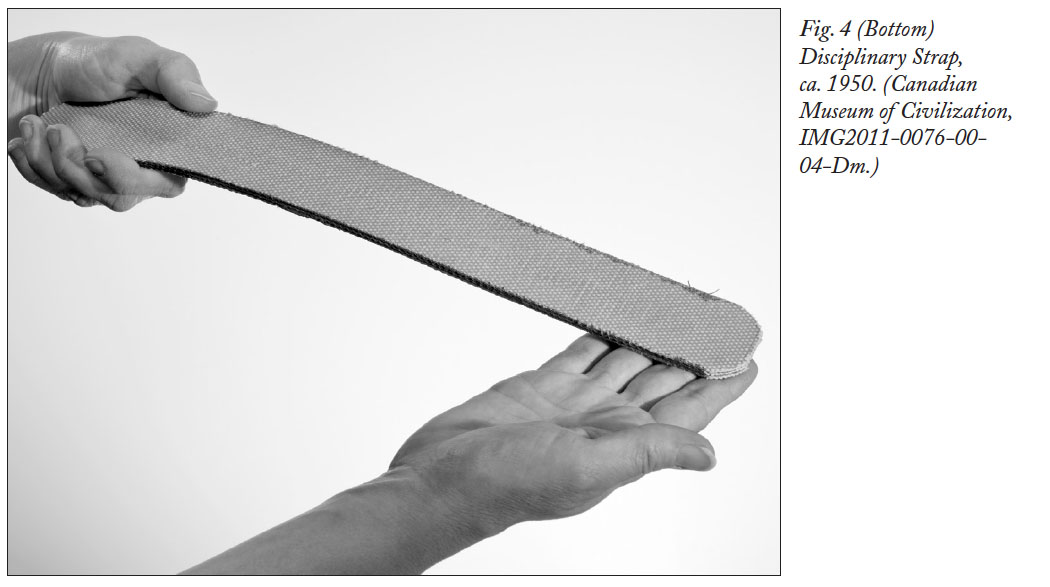 Display large image of Figure 4
Display large image of Figure 415 As a basis of research for the study of educational history, however, much more remains to be understood about the strap and its impact on the psychological development of Canadian children in the classroom. The material object itself, in this regard, can tell us more about its use. The shape, size, wear and type of the strap offers a much more vivid, if horrifying, explanation of how and how often the strap was used on children. Consider, for example, the extant material evidence of leather straps in the Ottawa valley in the 20th century. At least two leather straps from the mid-20th century were part of the Ottawa Catholic School Board Collection. Such material evidence should not exist, because in the 20th century leather straps were banned from use in schools. Their existence, however, reminds us that they were indeed still used, even though they were unauthorized. Historian Paul Axelrod makes a similar point that despite the banning of corporal punishment from Toronto schools in 1971, it continued to be employed throughout Ontario well into the 1980s. Surprisingly, the use of physical discipline was prohibited in all Canadian schools only in 2004 (Axelrod 2010). The material evidence that the leather strap remained in use well into the 20th century serves as a tangible reminder of what was going on inside of the classroom, even if debates outside of the classroom seemed settled.
Teaching Aids and Pedagogy
16 If one considers the Ottawa Catholic School Board Collection a micro-history of the material culture of Canadian classrooms, then we can assume that very few teaching aids were used in the 19th century. In fact, aside from books and writing equipment, we do not find many pedagogical aids in the material evidence until after the First World War. The Ontario Educational Exhibit at the 1876 Centennial International Exposition in Philadelphia boasted an impressive array of educational apparatuses and instruments in its glass cases (Fig. 5). The records of the Department of Education, and certain historians, suggest that this exhibit demonstrated to the world the developments in education made under Egerton Ryerson from the mid- to late 19th century (Stamp 1982; Mah 2007). Deputy Minister of Education and designer of the Ontario educational display in Philadelphia John George Hodgins stressed the importance of these objects to the educational plans of Egerton Ryerson and the Departments of Education in western Canada and Ontario (Hodgins 1852, 1877). Juxtaposing pictures such as those of the Philadelphia exposition with the extant material evidence, however, shows that the Ontario exhibit was more of an ideal than a reality.
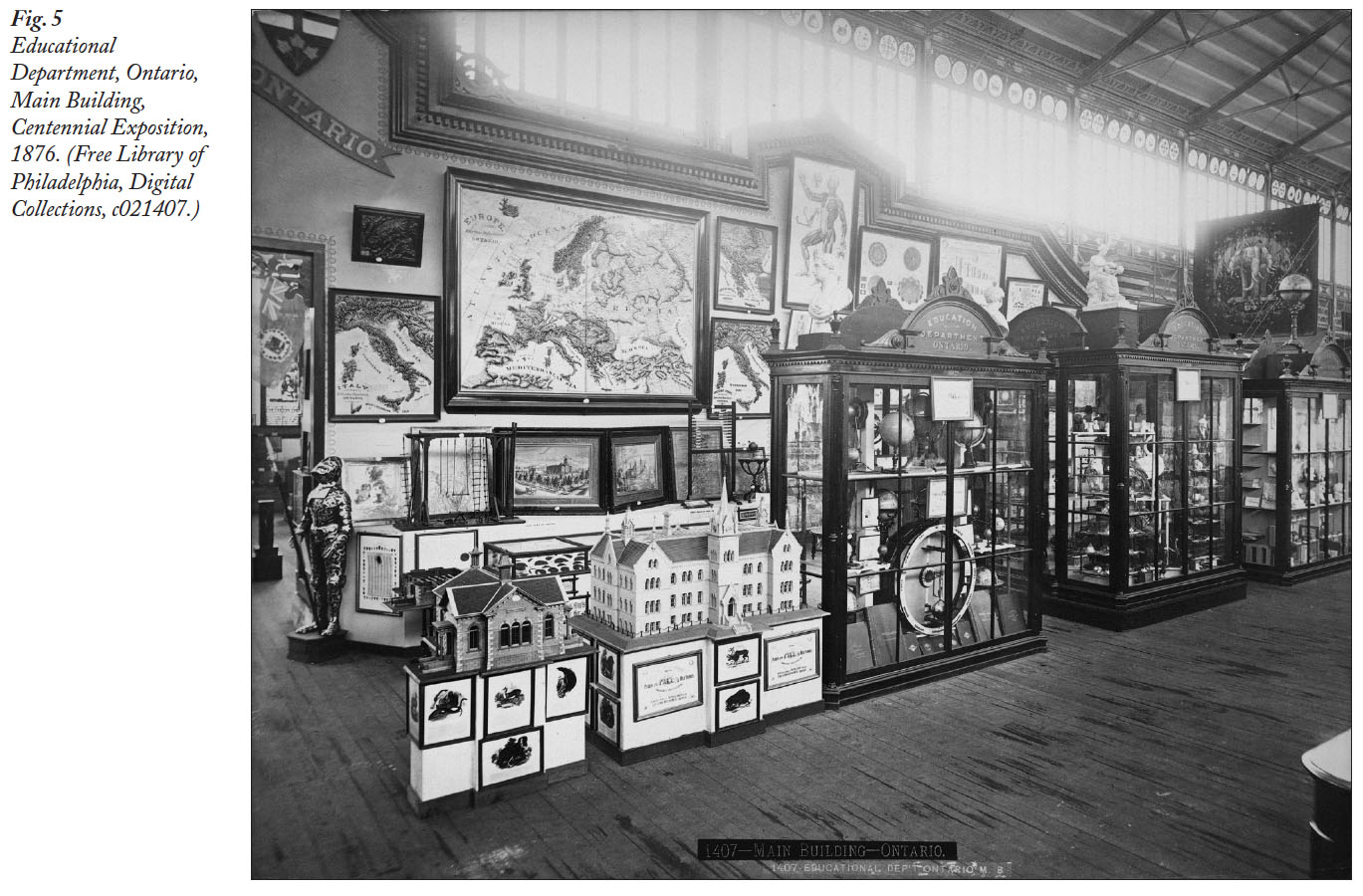 Display large image of Figure 5
Display large image of Figure 517 In fact, the material evidence of teaching aids suggests a very basic pedagogy that continued into the 20th century. Slates, a staple of early 19th-century pedagogical tools intended to facilitate large bodies of students at minimal expense, were still extremely common in the late 19th century, and continued to be used in Canadian schools well into the 20th century (Fig. 6). Again, there seems to be a disconnection between the documentary and material evidence: whereas state records, teachers’ journals and the writing of prominent educators suggest advancements in pedagogy, the masses, according to the material evidence, were in fact receiving instruction in the early 20th century in much the same way that their ancestors were in the early 19th century.
18 What can the material culture evidence from this collection tell us, then, about the history and development of schooling? On one hand, as stated above, we should be careful not to make too many broad generalizations. The teaching material and resources contained in this collection, or lack thereof, in many ways represent the limits and constraints that many of the schools faced when it came to purchasing decisions. Nevertheless, like the school furniture, the collection does suggest a historical divide between ideas about pedagogical resources as imagined by central authorities and educational thinkers at the top and what was actually used at the local level in the schools. Indeed, one does not have to look far to see that divide continuing in contemporary educational discourse today. Despite decades of technological and digital advancements in pedagogical material, the vast majority of schools throughout Canada still contain chalkboards and textbooks as central teaching material. What does this tell us about the nature and pace of educational change? Are our schools continually playing catch-up to material advances? Or, does what goes on inside of classrooms in fact have less to do with the teaching material used inside of them than we might suppose?
Cleanliness, Health and Hygiene
19 Surviving classroom artifacts, such as mud and slush shoe cleaners, show that efforts were made to keep schools clean places (Fig. 7). However, other surviving artifacts suggest that cleanliness, health and hygiene were challenging issues. Surviving lunch boxes, for example, highlight that exposure to germs and bacteria were a common part of the daily experience of schooling. The typical metal colonial lunchbox usually contained a compartment on the top to store a child’s drink (usually milk) throughout the day. With new routines of life in the 19th century, such as spending the day away from home and at school, came the increased exposure to bacteria and germs. This exposure to germs multiplied when coupled with limited access to running water at school and outhouses without sinks in which to wash hands. Indeed, surviving ladles and bowls in the collection offer further evidence of increased exposure to health risks as they show that many children shared lunch room dishes; germs would have easily spread this way.
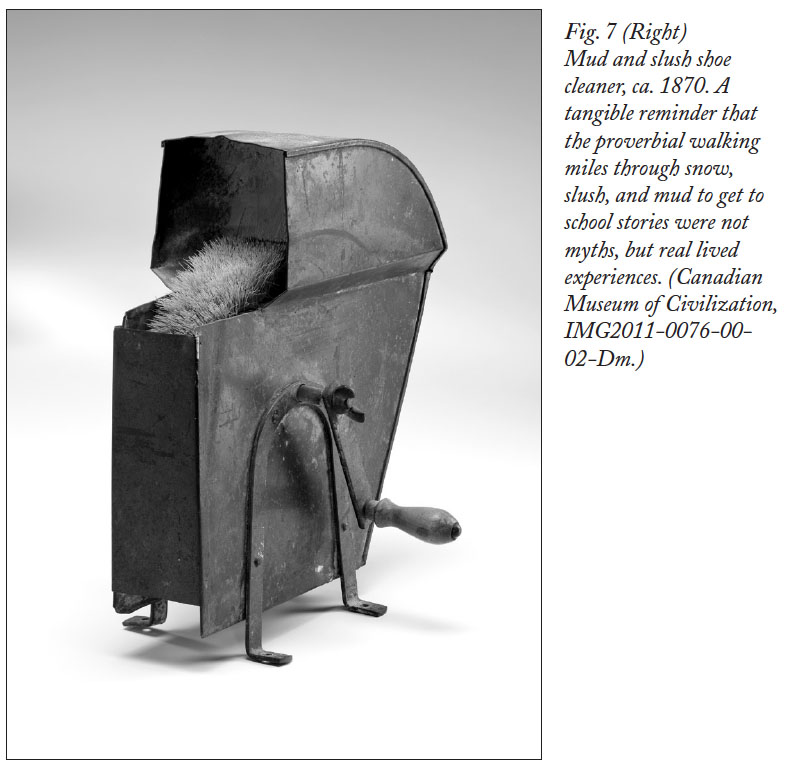 Display large image of Figure 7
Display large image of Figure 720 By the late 19th century, however, schools were taking health more seriously (Sutherland 2000; Gleason 2006). This is clearly seen in the profusion of medical supplies and apparatuses in the classrooms (Fig. 8). These artifacts also remind us that going to school, much like going to a hospital, often put children at risk of acquiring some sort of illness. Health and sanitation continued to grow in importance throughout the 20th century, and surviving artifacts demonstrate that 20th-century classrooms were littered with eye examination charts, first aid kits, toothbrushes, soaps and fountains and even pharmaceuticals such as cod liver extract, distributed widely after the Second World War period to boost levels of vitamin D to prevent rickets, a softening of the bones in children.
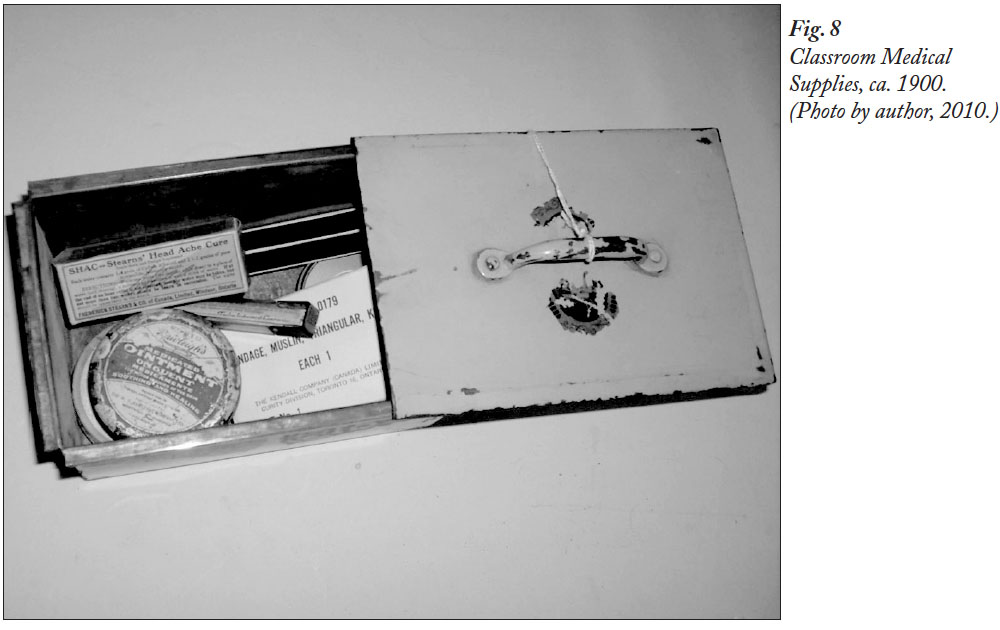 Display large image of Figure 8
Display large image of Figure 8Symbolic Representations of National Identity in the Classroom
21 Symbols of national identity have been profuse in Canadian classrooms since the 19th century. These symbols have transmitted to students certain ideas and cultural values that have shaped their identities. To be sure, the idea that values and identity have been promoted through schooling is not new. What is striking in the material evidence offered by the Ottawa Catholic School Board Collection, however, is how much more predominant in the classroom national symbols have been than local symbols. Considering that the constitutional jurisdiction and legal administration of education in Canada belong to provincial governments, this domination of national symbols is rather significant. Have they provided for a shared national experience and material reality inside of Canadian classrooms? Have they created an unofficial national curriculum within a provincial jurisdiction?
22 What can we learn about the symbolic representations of Canada from a material analysis of the sources, ranging from overt symbols such as flags to discreet ones hidden within the everyday curriculum of classroom teaching (see Fig. 9)? 1 Consider maps, for example, which provide striking evidence of Canadian nationalism. Few maps in the Ottawa Catholic School Board collection are of provinces or cities, while maps of Canada overwhelmingly dominate. The famous Neilson maps of the 20th century (Fig. 10), distributed to teachers throughout Canada free of charge by the Neilson company, provide us with an interesting example of corporate Canada’s ability to enter into the classroom and shape the experience of schooling for Canadian children (Gidney and Gidney 2008). While different teachers in different parts of Canada might have used those maps in different ways, their material reality inside of classrooms, from sea to sea, was certainly a shared experience. This material reality raises some questions in the history of education worth further exploration. In what ways were school children throughout Canada connected by their material surroundings? In what ways could they begin to imagine a shared Canadian national community?
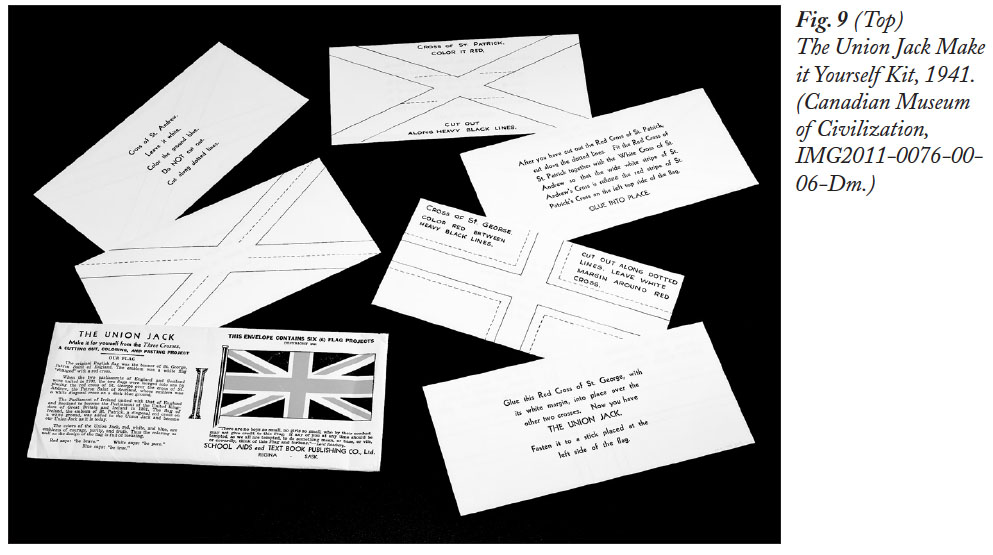 Display large image of Figure 9
Display large image of Figure 9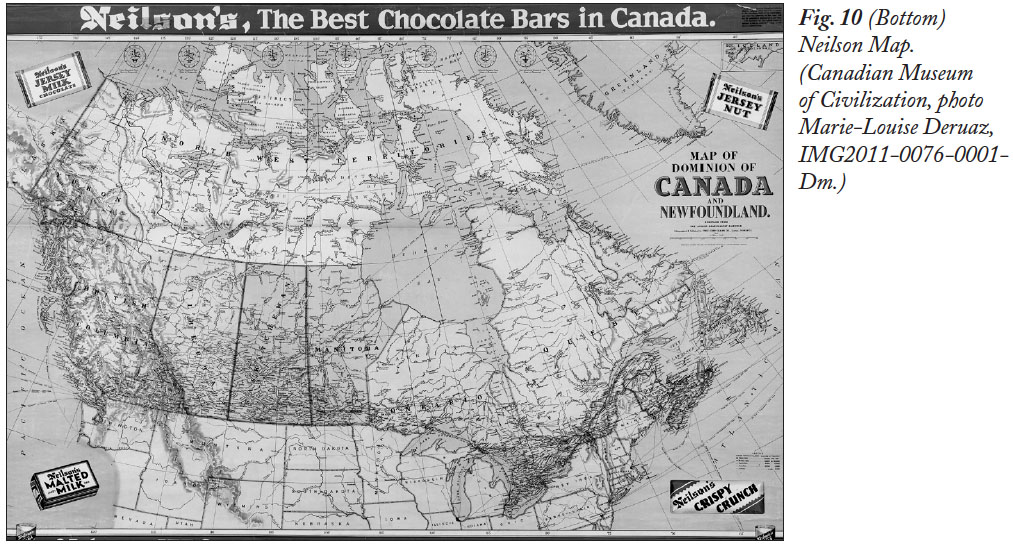 Display large image of Figure 10
Display large image of Figure 1023 Rural Saskatchewan poet Glen Sorestad, who went through the school system in the 1940s and 1950s, has captured the idea of a shared national experience extremely well in his poem, titled “Neilson’s Map of Canada.” “I know that I am not alone,” he says in remembering those maps,
Sorestad’s memory of those maps is not limited to his experience alone. In his poem, he speaks with certainty that this was a shared pan-Canadian experience. A more recent example of efforts to create a pan-Canadian experience comes from the distribution of civics learning material from outsiders such as Elections Canada, which, among dozens of other resources, distributes Canada At the Polls!, a simulation election kit that can be ordered and sent directly to the classroom without provincial consent being necessary.
24 In a study on the teaching of Canadian history, historian J. L. Granatstein warned of the regionalized nature of Canadian education and its potential to destroy nationalism at the federal level (Granatstein 1998). History as taught in the schools was, he claimed, regionalized, resulting in a fragmented sense of Canadian identity at best. The material culture of education as seen through the Ottawa Catholic School Board Collection, however, suggests that much of the material inside of schools has in fact reinforced the integration of local communities into a national society and culture. Norris Brock Johnson finds the same in his study of the material culture of schooling in the midwestern United States, suggesting that classroom material culture is an index of the relative degree of symbolic integration between local school communities and national society and culture (Johnson 1980). Andrew Saint points out how an inner suburb of London, U.K., has grappled with the social and cultural consciousness of the nation and the locality through an examination of the urban planning of its schools and an analysis of the architecture and the physical design and layout of the interior of the schools themselves (Saint 2010). The material culture of education can open our eyes, and our research, to the variety of influences inside of schools and classrooms that shape how children come to identify themselves and their place in the broader world.
Conclusion
25 The Ottawa Catholic School Board Collection offers many directions in which a material culture examination of schooling can be taken, sometimes from the same view as school children long gone. Indeed, the beauty of a material culture analysis is that while the vast majority of school children have not left behind written accounts of their school memories, we do have before us a plethora of objects they used. In the surviving artifacts, we possess a manifestation of one of the central aims of social history in the last fifty years; namely, these artifacts offer a history of the anonymous masses. A synthesis of this three-dimensional cultural data and the documentary history of mass schooling will offer a new way to understand what the experiences of schooling, and, by extension, of growing up, were for school children.
26 In “The Truth of Material Culture,” Jules David Prown suggests that the great promise of material culture is that it allows us to approach the past “mindlessly” and without the bias of our intellect (Prown 1993: 17). While that suggestion may be couched more in hope than in reality, material culture does allow us to engage with the past with both our minds and our senses. We can literally see, feel, smell, hear and even taste schooling in some of the same ways as children of the 19th and 20th centuries. By allowing us to see schooling through their eyes, and to touch it as they did, these materials allow us to identify with school children from the past empathetically and to understand their experiences very differently from how we would through the written record alone.
I would like to acknowledge the support of a research fellowship at the Canadian Museum of Civilization, which made this study possible. In particular, I would like to thank Rhonda Hinther for introducing me to this collection and John Willis for his support while I worked on it. At the Ottawa Catholic School Board, I owe a special debt of gratitude to Lou Ann Cousins and Fred Chrystal. They provided me with not only access to the collection at the board’s main office, but also with hospitality, generosity and kindness during my time there.
